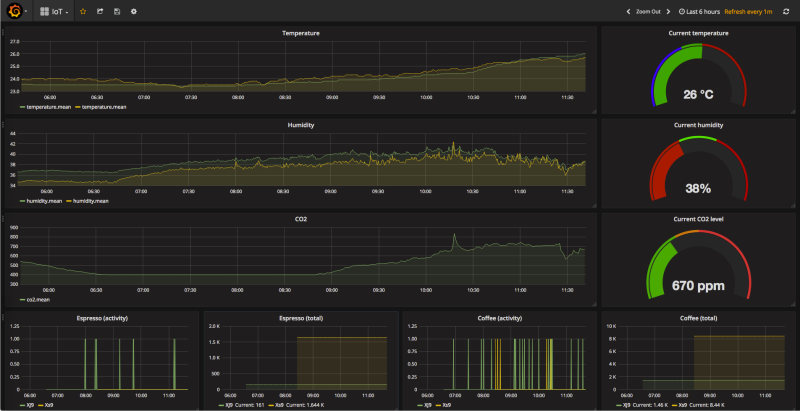If there’s one thing that characterizes the Information Age that we find ourselves in today, it is streams of data. However, without proper ways to aggregate and transform this data into information, it’ll either vanish into the ether or become binary blobs gathering virtual dust on a storage device somewhere. Dealing with these streams of data is thus essential, whether it’s in business (e.g. stock markets), IT (e.g. services status), weather forecasting, or simply keeping tracking of the climate and status of devices inside a domicile.
The first step of aggregating data seems simple, but rather than just writing it to a storage device until it runs out of space like a poorly managed system log, the goal here isn’t merely to record, but also to make it searchable. After all, for information transformation we need to be able to efficiently search and annotate this data, which requires keeping track of context and using data structures that lend themselves to this.
For such data aggregation and subsequent visualization of information on flashy dashboards that people like to flaunt, there are a few mainstream options, with among ‘smart home’ users options like InfluxDB and Grafana often popping up, but these are far from the only options, and depending on the environment there are much more relevant solutions.
Don’t Call It Data Hoarding
 Although the pretty graphs and other visualizations get most of the attention, the hard part comes with managing the incoming data streams and making sure that the potentially gigabytes of data that come in every day (or more, if you work at CERN), are filed away in a way that makes retrieval as easy as possible. At its core this means some kind of database system, where the data can be transformed into information by stuffing it into the appropriate table cells or whatever equivalent is used.
Although the pretty graphs and other visualizations get most of the attention, the hard part comes with managing the incoming data streams and making sure that the potentially gigabytes of data that come in every day (or more, if you work at CERN), are filed away in a way that makes retrieval as easy as possible. At its core this means some kind of database system, where the data can be transformed into information by stuffing it into the appropriate table cells or whatever equivalent is used.
For things like sensor data where the data format tends to be rather simple (timestamp and value), a time series database (TSD) can be an efficient option as the full feature set of e.g. a full-fat SQL database like MySQL/MariaDB or PostgreSQL is unneeded. There are also a lot of open source options out there, making TSD users spoiled for choice. For example:
- InfluxDB – Partially open source, with version 3 being less of a successor and more of its own ‘edge data collector’ thing. Somewhat controversial due to the company’s strong commercial focus.
- Apache Kudu – Column-based database optimized for multidimensional OLAP workloads. Part of the Apache Hadoop distributed computing ecosystem.
- Prometheus – Developed at SoundCloud to support metrics monitoring. Also written in Go like InfluxDB v1 and v2.
- RRDTool – An all-in-one package that provides a circular buffer TSD that also does graphing and has a number of bindings for various programming languages.
- Graphite – Similar to RRDTool, but uses a Django web-based application to render graphs.
- TimescaleDB – Extends PostgreSQL and thus supports all typical SQL queries like any other relational database. The extensions focus on TSD functionality and related optimizations.
The internal implementations of these databases differ, with InfluxDB’s storage engine splitting the data up in so-called shards, which can be non-compacted ‘hot’ shards, or compacted ‘cold’ shards. The main purpose of this is to reduce the disk space required, with four compaction levels (including delta compression) used while still retaining easy access to specific time series using a time series index. The shard retention time can be optionally set within the database (‘bucket’) to automatically delete older shards.
A circular buffer as used by RRDTool dodges much of this storage problem by simply limiting how much data can be stored. If you do not care about historical data, or are happy to have another application do this long-term storage, then such a more simple TSD can be a lightweight alternative.
Pretty Graphs

While some of the TSDs come with their own graphing system, others rely on third-party solutions. The purpose of this graphing step is to take the raw data in the TSD and put them into a graph, a table or some other kind of visualization. When multiple of such visualizations are displayed concurrently and continuously, it’s called a ‘dashboard’, which is what software like Grafana allows you to create.
As an example of such a system, there is the Building Management and Control (BMaC) project that I created a few years ago. In addition to being able to control things like the airconditioning, the data from multiple sensors constantly get written into an InfluxDB bucket, which in the office test environment included such essentials like the number of cups of regular coffee and espresso consumed at the Jura coffee makers with their TOP-tronics brains, since this could be read out of their Flash memory.
With this visualization dashboard it’s easy to keep track of room temperature, air quality (CO2) and when to refill the beans in the coffee machines. Transforming raw data into such a dashboard is of course just one way to interpret raw data, with generating one-off graphs for e.g. inclusion in reports being another one. Which type of transformation is the right one thus depends on your needs.
In a more dynamic environment like system monitoring, you would likely prefer something like Nagios. This features clients that run on the systems being monitored and submit status and event reports, with a heavy focus on detecting problems within e.g. a server farm as soon as possible.
Complications
Everyone who has ever done anything with software knows that the glossy marketing flyers omit a lot of the factual reality. So too with TSDs and data visualization software. During the years of using Grafana and InfluxDB mostly in the context of the BMaC project, one of the most annoying things was the installation, which for Grafana means either downloading a package or using their special repository. Meanwhile for InfluxDB you will use their special repository no matter what, while on Windows you get the raw binaries and get to set things up by hand from there.
Another annoyance with InfluxDB comes in the form of its lack of MQTT support, with only its HTTP line protocol and its SQL-dialect available as ways to insert new time series data. For BMaC I had to write a special MQTT-to-HTTP bridge to perform the translation here. Having a TSD that directly supports the data protocol and format would be a real bonus, if it is available for your use case.
Overall, running a TSD with a dashboard can be very shiny, but it can be a serious time commitment to set up and maintain. For dashboards you’re also basically limited to Grafana with all its quirks, as the project it was forked from (Kibana) only supports ElasticSearch as data source, while Grafana supports multiple TSDs and even plain SQL databases like MariaDB and PostgreSQL.
It’s also possible to create a (free) online account with Grafana to gain access to a Prometheus TSD and Grafana dashboard, but this comes with the usual privacy concerns and the need to be online 24/7. Ultimately the key is to have a clear idea beforehand of what the problem is that you’re trying to solve with a TSD and a graphing solution or dashboard.
















Might be worth noting that Graphite uses carbon-cache to actually store the data, which uses rrdtool for its “whisper” databases.
One thing I’ve noticed with Grafana is that it is far more configurable when it comes to superficial stuff like themes than when it comes to functional stuff like how you map your data to each chart, what keys must be the same for all views on a dashboard vs. what keys can be changed independently for each widget, etc. Ultimately this is an area where any tool that promises a “Do What I Mean” button (rather than the some serious scripting required you’d expect with gnuplot or matplotlib) will be full of “you can’t get there from here” cases that they elide over in the glossy marketing materials.
The last time I worked on a project that was forced to conform to use Grafana for dashboards and some clunky proprietary metrics streaming engine to transport data from the edge it ended up being necessary to stick a bunch of unpack / rollup / repack scripts to make a bunch of table views formatted in a way that worked around Grafana’s limitations and assumptions. If you’re free to choose your front end interface, definitely do your research since they all have blind spots and assumptions baked in.
Multiple important things missing – for example no mention of cardinality – very important topic for TSD – let’s take Prometheus for example
Each metrics is represented by it’s name and arbitrary number of labels, which can have any value you want BUT – each combination of name+labels+values is it’s oven time series. It’s easy to make a mistake and put for example transaction ID of something similar into label value – at first it looks fine, but very quickly it does not.
Also Push VS Pull – InfluxDB for example is push, you put data into it when you want. Prometheus on the other hand is pull – it scrapes HTTP endpoints for data in predefined intervals.
Now for pull – Prometheus – you don’t usually send “current value” if the value may change abruptly, as that change can be missed (as the interval for pull is fixed), instead you use counters, but than you need to deal with time derivative functions, as you need to get from for example “total bytes transferred” (counter) to “bytes/s” and oh boy that can get very ugly very quickly. Prometheus btw is really designed for monitoring rather than as generic TSD.
Don’t forget to mention https://victoriametrics.com/ which is a drop-in replacement for Prometheus with better storage efficiency and faster query speed (also featuring more powerful, extended query language).
For home enthusiasts, the free community edition should be all you need, for $work, the enterprise variant allows a clustered installation mode – though quite a bit more complicated to set up
+1 for victoriametrics, it just works.
+1 for VictoriaMetrics
Can run on a RPi Gen. 1 – and will do so better than any of the others on Gen.3 or even Gen.4. It’s crazy how optimized it is.
Grafana works fine with larger datasets in MariaDB (did not care for InnoDB) on older Pis. Just remember to limit the results and use Grafana’s built-in time filter (where time > x and time < x+y).
I love adafruit io for this stuff.
Use time series databases with Grafana for powerful data aggregation and real-time visualization.
Use time series databases with Grafana for clear data visualization—just like Roblox APK gives a smooth view into your gaming world!
for more visit this site https://rblapkdownload.com/
InfluxDB sends your data to China
Really?
Recent entrants into the TSD are are QuestDB and TDengine. I got tired of InfluxDB’s delays with V3 and their odd OSS options. V3 did not solve the problems either. I moved to QuestDB for three main reasons: First, it can use the InFluxDB Line Protocol making it an easy(ish) drop-in replacement. Second, you can use proper SQL instead of the botched query language of InfluxDB. Third, it works with Telegraf and Grafana so the MQTT side of things is covered. And talking of Telegraph; you did not mention it which, in my view, was an oversight.
Time series databases store time stamped data efficiently. Tools like Grafana help visualize this data with real time dashboards. best for monitoring metrics, logs, and IoT data.